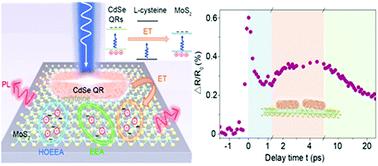当前位置:
X-MOL 学术
›
Nanoscale Horiz.
›
论文详情
Our official English website, www.x-mol.net, welcomes your
feedback! (Note: you will need to create a separate account there.)
Photoluminescence enhancement of MoS2/CdSe quantum rod heterostructures induced by energy transfer and exciton-exciton annihilation suppression.
Nanoscale Horizons ( IF 8.0 ) Pub Date : 2020-03-31 , DOI: 10.1039/c9nh00802k Yang Luo 1 , Hangyong Shan , Xiaoqing Gao , Pengfei Qi , Yu Li , Bowen Li , Xin Rong , Bo Shen , Han Zhang , Feng Lin , Zhiyong Tang , Zheyu Fang
Nanoscale Horizons ( IF 8.0 ) Pub Date : 2020-03-31 , DOI: 10.1039/c9nh00802k Yang Luo 1 , Hangyong Shan , Xiaoqing Gao , Pengfei Qi , Yu Li , Bowen Li , Xin Rong , Bo Shen , Han Zhang , Feng Lin , Zhiyong Tang , Zheyu Fang
Affiliation

|
Energy transfer in heterostructures is an essential interface interaction for extraordinary energy conversion properties, which promote promising applications in light-emitting and photovoltaic devices. However, when atomic-layered transition metal dichalcogenides (TMDCs) act as the energy acceptor because of strong Coulomb interactions, the transferred energy can be consumed by nonradiative exciton annihilations, which hampers the development of light-emitting devices. Hence, revealing the mechanism of energy transfer and the related relaxation processes from the aspect of the acceptor in the heterostructure is key to reducing nonradiative loss and optimizing luminescence. Here, we study the exciton dynamics from the standpoint of the acceptor in MoS2/CdSe quantum rod (QR) heterostructures and realize efficiently enhanced photoluminescence (PL). Through femtosecond pump–probe measurements, it is directly observed that energy transfer from CdSe QRs largely raises the exciton population of the acceptor, MoS2, providing a larger emission “source”. In addition, the dielectric environment introduced by CdSe QRs efficiently enhances the PL by suppressing exciton–exciton annihilation (EEA). This study provides new insights for on-chip applications such as light-emitting diodes and optical conversion devices based on low dimensional semiconductor heterostructures.
中文翻译:

能量转移和激子-激子an灭抑制引起的MoS2 / CdSe量子棒异质结构的光致发光增强。
异质结构中的能量转移是实现非凡能量转换特性的必不可少的界面相互作用,这促进了在发光和光伏设备中的应用前景。但是,当由于强库仑相互作用而使原子层过渡金属二硫化二氢(TMDC)用作能量受体时,传递的能量会因非辐射激子an灭而被消耗,从而阻碍了发光器件的发展。因此,从异质结构中受体的角度揭示能量转移的机理和相关的弛豫过程是减少非辐射损失和优化发光的关键。在这里,我们从MoS 2中受主的角度研究激子动力学。/ CdSe量子棒(QR)异质结构,并有效地增强了光致发光(PL)。通过飞秒泵浦探针测量,可以直接观察到CdSe QRs的能量转移在很大程度上增加了受体MoS 2的激子数量,从而提供了更大的发射“源”。此外,CdSe QRs引入的介电环境通过抑制激子-激子an灭(EEA)来有效地增强了PL。这项研究为片上应用提供了新的见解,例如基于低维半导体异质结构的发光二极管和光学转换器件。
更新日期:2020-03-31
中文翻译:

能量转移和激子-激子an灭抑制引起的MoS2 / CdSe量子棒异质结构的光致发光增强。
异质结构中的能量转移是实现非凡能量转换特性的必不可少的界面相互作用,这促进了在发光和光伏设备中的应用前景。但是,当由于强库仑相互作用而使原子层过渡金属二硫化二氢(TMDC)用作能量受体时,传递的能量会因非辐射激子an灭而被消耗,从而阻碍了发光器件的发展。因此,从异质结构中受体的角度揭示能量转移的机理和相关的弛豫过程是减少非辐射损失和优化发光的关键。在这里,我们从MoS 2中受主的角度研究激子动力学。/ CdSe量子棒(QR)异质结构,并有效地增强了光致发光(PL)。通过飞秒泵浦探针测量,可以直接观察到CdSe QRs的能量转移在很大程度上增加了受体MoS 2的激子数量,从而提供了更大的发射“源”。此外,CdSe QRs引入的介电环境通过抑制激子-激子an灭(EEA)来有效地增强了PL。这项研究为片上应用提供了新的见解,例如基于低维半导体异质结构的发光二极管和光学转换器件。











































 京公网安备 11010802027423号
京公网安备 11010802027423号